Cross-Cultural Leadership Report: Spain and United Kingdom Analysis
VerifiedAdded on 2023/01/13
|9
|3356
|69
Report
AI Summary
This report provides a comprehensive analysis of cross-cultural leadership, focusing on the cultures of Spain and the United Kingdom. It begins with an introduction to cross-cultural leadership and its importance, followed by an in-depth examination of Spanish culture, including its historical influences and societal characteristics. The report then discusses two suitable leadership approaches—collaborative and transformational leadership—highlighting their relevance in the Spanish context and their impact on future team leaders. A review of human capital management statistics from Spain and the UK is presented, comparing their rankings and identifying gaps in human capital development. The report concludes by addressing the challenges future leaders may face, particularly those arising from technological advancements and the evolving workforce, such as the reduced importance of human capital and the increased use of robots. The report emphasizes the need for leaders to adapt their strategies to meet the demands of a changing business environment.
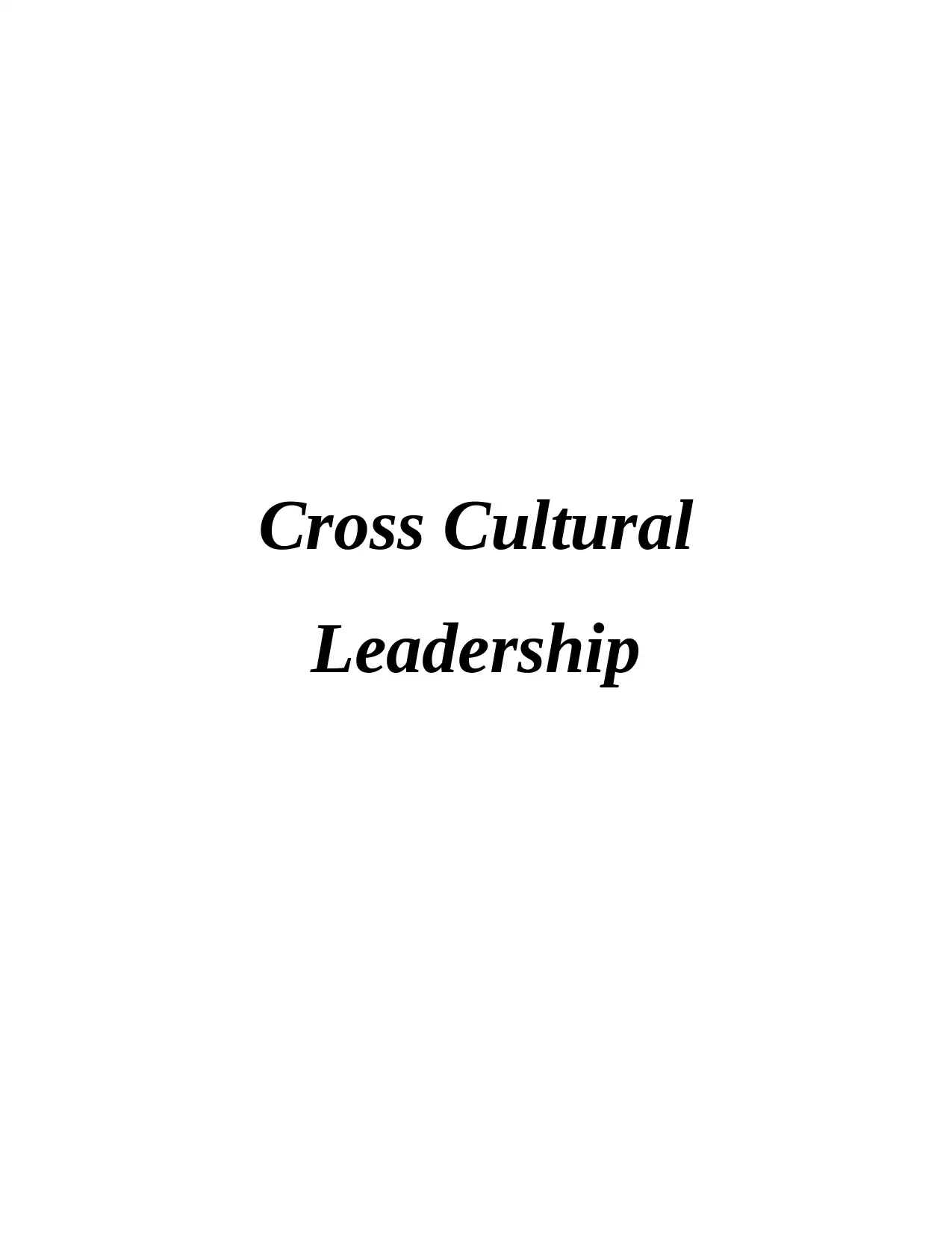
Cross Cultural
Leadership
Leadership
Paraphrase This Document
Need a fresh take? Get an instant paraphrase of this document with our AI Paraphraser
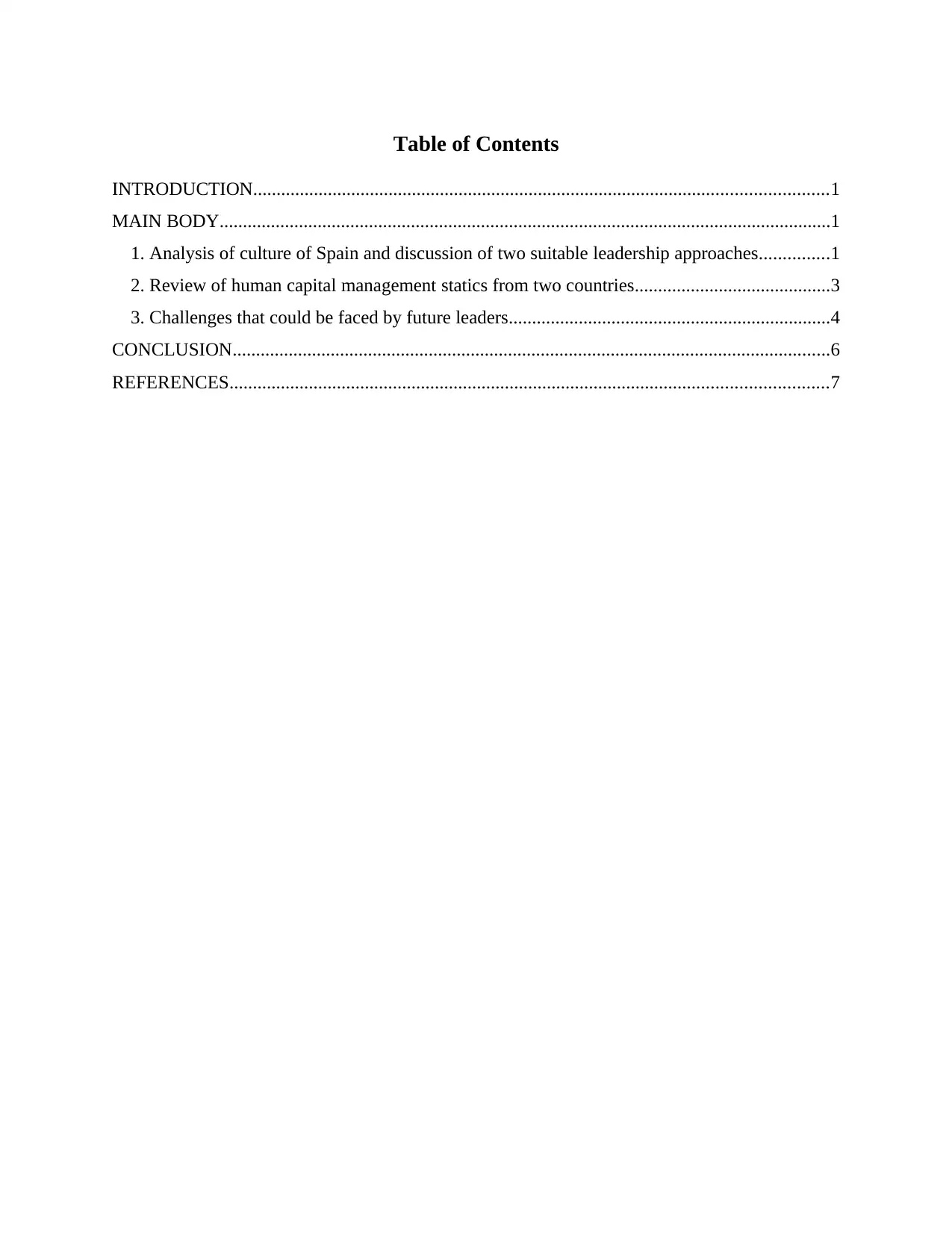
Table of Contents
INTRODUCTION...........................................................................................................................1
MAIN BODY...................................................................................................................................1
1. Analysis of culture of Spain and discussion of two suitable leadership approaches...............1
2. Review of human capital management statics from two countries..........................................3
3. Challenges that could be faced by future leaders.....................................................................4
CONCLUSION................................................................................................................................6
REFERENCES................................................................................................................................7
INTRODUCTION...........................................................................................................................1
MAIN BODY...................................................................................................................................1
1. Analysis of culture of Spain and discussion of two suitable leadership approaches...............1
2. Review of human capital management statics from two countries..........................................3
3. Challenges that could be faced by future leaders.....................................................................4
CONCLUSION................................................................................................................................6
REFERENCES................................................................................................................................7

INTRODUCTION
Cross cultural leadership can be defined as the ability of an individual to deal with other
and treat them properly in different cultures. Main purpose of it is to guide all the staff members
who are working under a leader (Bird and Mendenhall, 2016). For all the supervisors it is very
important to make sure that they pay attention towards all the needs and requirements of
subordinates who are working under them. Present report is based upon cross cultural leadership
analysis in context of different countries around the world. This assignment covers various topics
such as assessment of cultural of Spain, suitable leadership styles, review upon human capital
management etc. Along with this, all the challenge which could be faced by leaders in future are
also covered in this report.
MAIN BODY
1. Analysis of culture of Spain and discussion of two suitable leadership approaches
Spain is one of the most beautiful countries around the world it is situated on Europe's
Iberian Peninsula. Its culture is based in a variety of historical influences which are based in the
Celtic of Rime and culture of Iberia. There are various other ancient people who has influences
upon it. These are Phoenicians, Carthaginian, Greeks, Romans etc. Rome created the Hispania as
a legal, administrative and political unit which has resulted in the lasting legacy in the Spanish
Culture in the areas of language and religion (Egel and Fry, 2017). Various subsequent courses
of the history of Span also added elements to the culture and traditions of the nation. 75% of the
Spanish language is derived from Latin because ancient Greek has contributed in the vocabulary
of Spain which left a great impact upon the culture.
Spain is considered as a country which is a mixture of different complex cultures. Most
of the citizens consider themselves Spanish, some of them consider Catalan, Galician or Basque.
Empire of Spain was began when America was discovered by Columbus in year 1492. It led the
colonisation of central and south parts of Mexico, America, Caribbean etc. Spain suffered from
critical hardship between years 1936 to 1939 as it was the time of civil war. It resulted in the 36
years of military dictatorship by Franco. It was faced by Spain until the death of General
Francisco Bahamonde (Culture of Spain, 2020). He was died in year 1975 and till this year
various difficulties were faced by Spain. Right after his death the country tried to establish
peaceful and collaborative society which resulted in the growth of economy and modernisation.
1
Cross cultural leadership can be defined as the ability of an individual to deal with other
and treat them properly in different cultures. Main purpose of it is to guide all the staff members
who are working under a leader (Bird and Mendenhall, 2016). For all the supervisors it is very
important to make sure that they pay attention towards all the needs and requirements of
subordinates who are working under them. Present report is based upon cross cultural leadership
analysis in context of different countries around the world. This assignment covers various topics
such as assessment of cultural of Spain, suitable leadership styles, review upon human capital
management etc. Along with this, all the challenge which could be faced by leaders in future are
also covered in this report.
MAIN BODY
1. Analysis of culture of Spain and discussion of two suitable leadership approaches
Spain is one of the most beautiful countries around the world it is situated on Europe's
Iberian Peninsula. Its culture is based in a variety of historical influences which are based in the
Celtic of Rime and culture of Iberia. There are various other ancient people who has influences
upon it. These are Phoenicians, Carthaginian, Greeks, Romans etc. Rome created the Hispania as
a legal, administrative and political unit which has resulted in the lasting legacy in the Spanish
Culture in the areas of language and religion (Egel and Fry, 2017). Various subsequent courses
of the history of Span also added elements to the culture and traditions of the nation. 75% of the
Spanish language is derived from Latin because ancient Greek has contributed in the vocabulary
of Spain which left a great impact upon the culture.
Spain is considered as a country which is a mixture of different complex cultures. Most
of the citizens consider themselves Spanish, some of them consider Catalan, Galician or Basque.
Empire of Spain was began when America was discovered by Columbus in year 1492. It led the
colonisation of central and south parts of Mexico, America, Caribbean etc. Spain suffered from
critical hardship between years 1936 to 1939 as it was the time of civil war. It resulted in the 36
years of military dictatorship by Franco. It was faced by Spain until the death of General
Francisco Bahamonde (Culture of Spain, 2020). He was died in year 1975 and till this year
various difficulties were faced by Spain. Right after his death the country tried to establish
peaceful and collaborative society which resulted in the growth of economy and modernisation.
1
⊘ This is a preview!⊘
Do you want full access?
Subscribe today to unlock all pages.

Trusted by 1+ million students worldwide
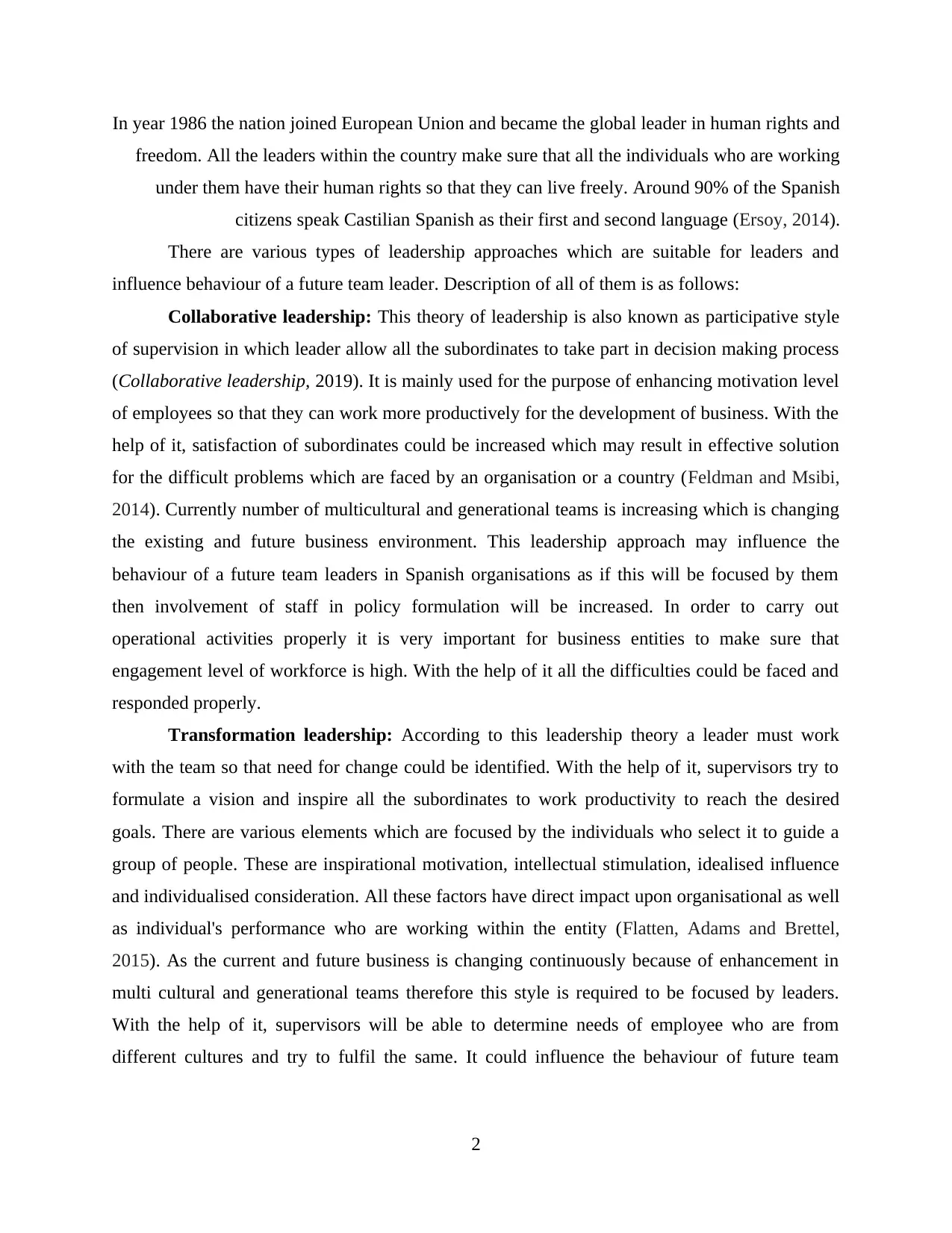
In year 1986 the nation joined European Union and became the global leader in human rights and
freedom. All the leaders within the country make sure that all the individuals who are working
under them have their human rights so that they can live freely. Around 90% of the Spanish
citizens speak Castilian Spanish as their first and second language (Ersoy, 2014).
There are various types of leadership approaches which are suitable for leaders and
influence behaviour of a future team leader. Description of all of them is as follows:
Collaborative leadership: This theory of leadership is also known as participative style
of supervision in which leader allow all the subordinates to take part in decision making process
(Collaborative leadership, 2019). It is mainly used for the purpose of enhancing motivation level
of employees so that they can work more productively for the development of business. With the
help of it, satisfaction of subordinates could be increased which may result in effective solution
for the difficult problems which are faced by an organisation or a country (Feldman and Msibi,
2014). Currently number of multicultural and generational teams is increasing which is changing
the existing and future business environment. This leadership approach may influence the
behaviour of a future team leaders in Spanish organisations as if this will be focused by them
then involvement of staff in policy formulation will be increased. In order to carry out
operational activities properly it is very important for business entities to make sure that
engagement level of workforce is high. With the help of it all the difficulties could be faced and
responded properly.
Transformation leadership: According to this leadership theory a leader must work
with the team so that need for change could be identified. With the help of it, supervisors try to
formulate a vision and inspire all the subordinates to work productivity to reach the desired
goals. There are various elements which are focused by the individuals who select it to guide a
group of people. These are inspirational motivation, intellectual stimulation, idealised influence
and individualised consideration. All these factors have direct impact upon organisational as well
as individual's performance who are working within the entity (Flatten, Adams and Brettel,
2015). As the current and future business is changing continuously because of enhancement in
multi cultural and generational teams therefore this style is required to be focused by leaders.
With the help of it, supervisors will be able to determine needs of employee who are from
different cultures and try to fulfil the same. It could influence the behaviour of future team
2
freedom. All the leaders within the country make sure that all the individuals who are working
under them have their human rights so that they can live freely. Around 90% of the Spanish
citizens speak Castilian Spanish as their first and second language (Ersoy, 2014).
There are various types of leadership approaches which are suitable for leaders and
influence behaviour of a future team leader. Description of all of them is as follows:
Collaborative leadership: This theory of leadership is also known as participative style
of supervision in which leader allow all the subordinates to take part in decision making process
(Collaborative leadership, 2019). It is mainly used for the purpose of enhancing motivation level
of employees so that they can work more productively for the development of business. With the
help of it, satisfaction of subordinates could be increased which may result in effective solution
for the difficult problems which are faced by an organisation or a country (Feldman and Msibi,
2014). Currently number of multicultural and generational teams is increasing which is changing
the existing and future business environment. This leadership approach may influence the
behaviour of a future team leaders in Spanish organisations as if this will be focused by them
then involvement of staff in policy formulation will be increased. In order to carry out
operational activities properly it is very important for business entities to make sure that
engagement level of workforce is high. With the help of it all the difficulties could be faced and
responded properly.
Transformation leadership: According to this leadership theory a leader must work
with the team so that need for change could be identified. With the help of it, supervisors try to
formulate a vision and inspire all the subordinates to work productivity to reach the desired
goals. There are various elements which are focused by the individuals who select it to guide a
group of people. These are inspirational motivation, intellectual stimulation, idealised influence
and individualised consideration. All these factors have direct impact upon organisational as well
as individual's performance who are working within the entity (Flatten, Adams and Brettel,
2015). As the current and future business is changing continuously because of enhancement in
multi cultural and generational teams therefore this style is required to be focused by leaders.
With the help of it, supervisors will be able to determine needs of employee who are from
different cultures and try to fulfil the same. It could influence the behaviour of future team
2
Paraphrase This Document
Need a fresh take? Get an instant paraphrase of this document with our AI Paraphraser
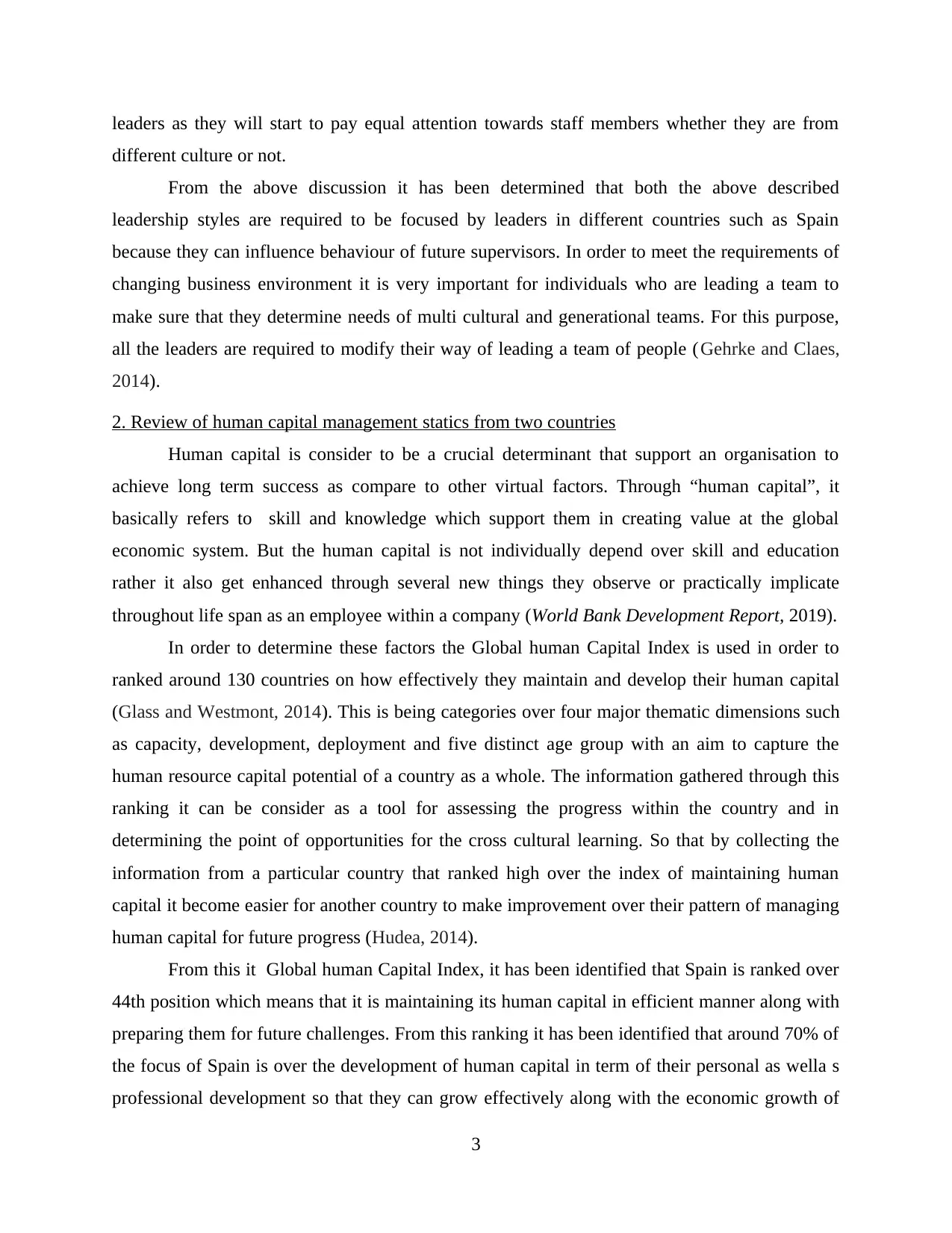
leaders as they will start to pay equal attention towards staff members whether they are from
different culture or not.
From the above discussion it has been determined that both the above described
leadership styles are required to be focused by leaders in different countries such as Spain
because they can influence behaviour of future supervisors. In order to meet the requirements of
changing business environment it is very important for individuals who are leading a team to
make sure that they determine needs of multi cultural and generational teams. For this purpose,
all the leaders are required to modify their way of leading a team of people (Gehrke and Claes,
2014).
2. Review of human capital management statics from two countries
Human capital is consider to be a crucial determinant that support an organisation to
achieve long term success as compare to other virtual factors. Through “human capital”, it
basically refers to skill and knowledge which support them in creating value at the global
economic system. But the human capital is not individually depend over skill and education
rather it also get enhanced through several new things they observe or practically implicate
throughout life span as an employee within a company (World Bank Development Report, 2019).
In order to determine these factors the Global human Capital Index is used in order to
ranked around 130 countries on how effectively they maintain and develop their human capital
(Glass and Westmont, 2014). This is being categories over four major thematic dimensions such
as capacity, development, deployment and five distinct age group with an aim to capture the
human resource capital potential of a country as a whole. The information gathered through this
ranking it can be consider as a tool for assessing the progress within the country and in
determining the point of opportunities for the cross cultural learning. So that by collecting the
information from a particular country that ranked high over the index of maintaining human
capital it become easier for another country to make improvement over their pattern of managing
human capital for future progress (Hudea, 2014).
From this it Global human Capital Index, it has been identified that Spain is ranked over
44th position which means that it is maintaining its human capital in efficient manner along with
preparing them for future challenges. From this ranking it has been identified that around 70% of
the focus of Spain is over the development of human capital in term of their personal as wella s
professional development so that they can grow effectively along with the economic growth of
3
different culture or not.
From the above discussion it has been determined that both the above described
leadership styles are required to be focused by leaders in different countries such as Spain
because they can influence behaviour of future supervisors. In order to meet the requirements of
changing business environment it is very important for individuals who are leading a team to
make sure that they determine needs of multi cultural and generational teams. For this purpose,
all the leaders are required to modify their way of leading a team of people (Gehrke and Claes,
2014).
2. Review of human capital management statics from two countries
Human capital is consider to be a crucial determinant that support an organisation to
achieve long term success as compare to other virtual factors. Through “human capital”, it
basically refers to skill and knowledge which support them in creating value at the global
economic system. But the human capital is not individually depend over skill and education
rather it also get enhanced through several new things they observe or practically implicate
throughout life span as an employee within a company (World Bank Development Report, 2019).
In order to determine these factors the Global human Capital Index is used in order to
ranked around 130 countries on how effectively they maintain and develop their human capital
(Glass and Westmont, 2014). This is being categories over four major thematic dimensions such
as capacity, development, deployment and five distinct age group with an aim to capture the
human resource capital potential of a country as a whole. The information gathered through this
ranking it can be consider as a tool for assessing the progress within the country and in
determining the point of opportunities for the cross cultural learning. So that by collecting the
information from a particular country that ranked high over the index of maintaining human
capital it become easier for another country to make improvement over their pattern of managing
human capital for future progress (Hudea, 2014).
From this it Global human Capital Index, it has been identified that Spain is ranked over
44th position which means that it is maintaining its human capital in efficient manner along with
preparing them for future challenges. From this ranking it has been identified that around 70% of
the focus of Spain is over the development of human capital in term of their personal as wella s
professional development so that they can grow effectively along with the economic growth of
3
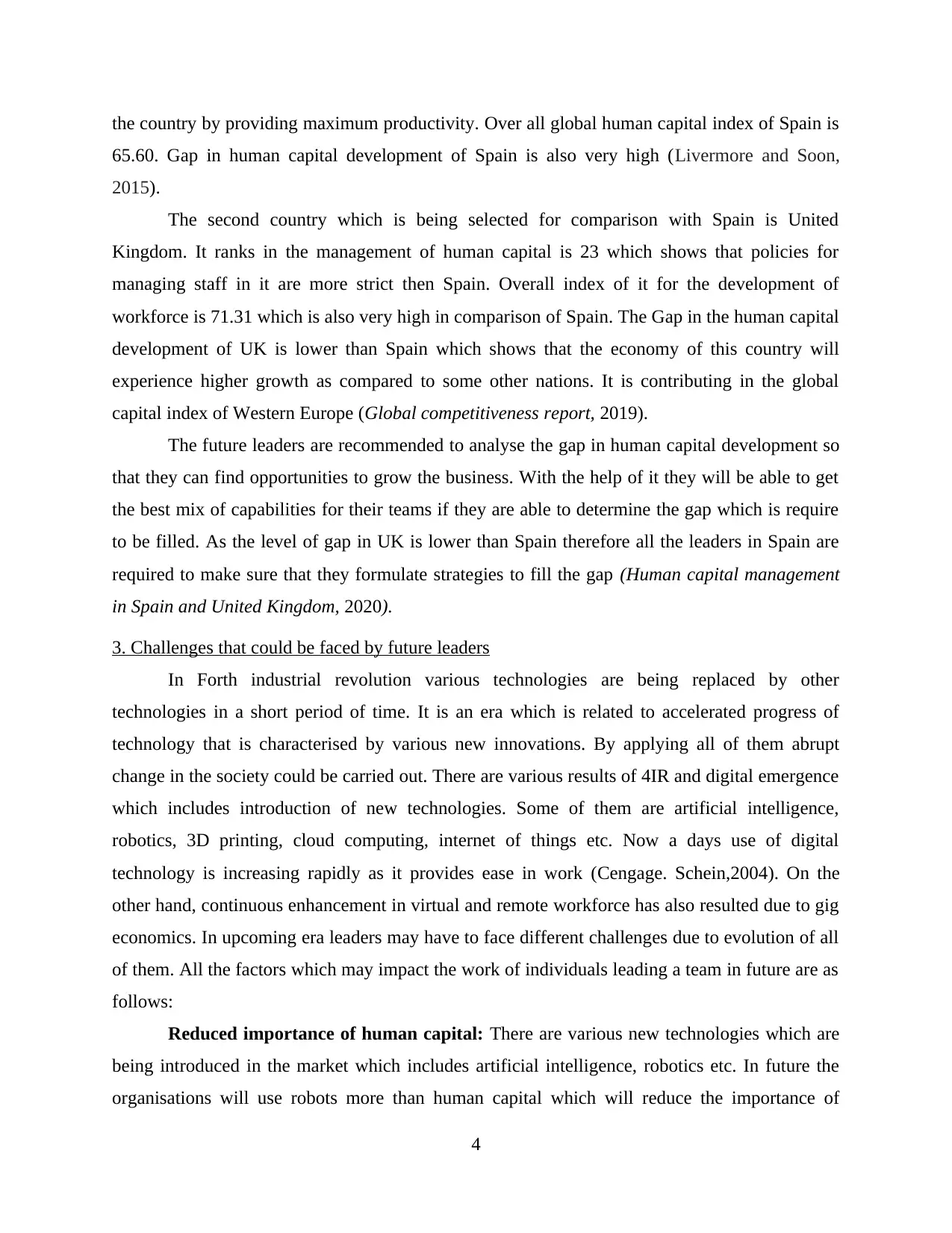
the country by providing maximum productivity. Over all global human capital index of Spain is
65.60. Gap in human capital development of Spain is also very high (Livermore and Soon,
2015).
The second country which is being selected for comparison with Spain is United
Kingdom. It ranks in the management of human capital is 23 which shows that policies for
managing staff in it are more strict then Spain. Overall index of it for the development of
workforce is 71.31 which is also very high in comparison of Spain. The Gap in the human capital
development of UK is lower than Spain which shows that the economy of this country will
experience higher growth as compared to some other nations. It is contributing in the global
capital index of Western Europe (Global competitiveness report, 2019).
The future leaders are recommended to analyse the gap in human capital development so
that they can find opportunities to grow the business. With the help of it they will be able to get
the best mix of capabilities for their teams if they are able to determine the gap which is require
to be filled. As the level of gap in UK is lower than Spain therefore all the leaders in Spain are
required to make sure that they formulate strategies to fill the gap (Human capital management
in Spain and United Kingdom, 2020).
3. Challenges that could be faced by future leaders
In Forth industrial revolution various technologies are being replaced by other
technologies in a short period of time. It is an era which is related to accelerated progress of
technology that is characterised by various new innovations. By applying all of them abrupt
change in the society could be carried out. There are various results of 4IR and digital emergence
which includes introduction of new technologies. Some of them are artificial intelligence,
robotics, 3D printing, cloud computing, internet of things etc. Now a days use of digital
technology is increasing rapidly as it provides ease in work (Cengage. Schein,2004). On the
other hand, continuous enhancement in virtual and remote workforce has also resulted due to gig
economics. In upcoming era leaders may have to face different challenges due to evolution of all
of them. All the factors which may impact the work of individuals leading a team in future are as
follows:
Reduced importance of human capital: There are various new technologies which are
being introduced in the market which includes artificial intelligence, robotics etc. In future the
organisations will use robots more than human capital which will reduce the importance of
4
65.60. Gap in human capital development of Spain is also very high (Livermore and Soon,
2015).
The second country which is being selected for comparison with Spain is United
Kingdom. It ranks in the management of human capital is 23 which shows that policies for
managing staff in it are more strict then Spain. Overall index of it for the development of
workforce is 71.31 which is also very high in comparison of Spain. The Gap in the human capital
development of UK is lower than Spain which shows that the economy of this country will
experience higher growth as compared to some other nations. It is contributing in the global
capital index of Western Europe (Global competitiveness report, 2019).
The future leaders are recommended to analyse the gap in human capital development so
that they can find opportunities to grow the business. With the help of it they will be able to get
the best mix of capabilities for their teams if they are able to determine the gap which is require
to be filled. As the level of gap in UK is lower than Spain therefore all the leaders in Spain are
required to make sure that they formulate strategies to fill the gap (Human capital management
in Spain and United Kingdom, 2020).
3. Challenges that could be faced by future leaders
In Forth industrial revolution various technologies are being replaced by other
technologies in a short period of time. It is an era which is related to accelerated progress of
technology that is characterised by various new innovations. By applying all of them abrupt
change in the society could be carried out. There are various results of 4IR and digital emergence
which includes introduction of new technologies. Some of them are artificial intelligence,
robotics, 3D printing, cloud computing, internet of things etc. Now a days use of digital
technology is increasing rapidly as it provides ease in work (Cengage. Schein,2004). On the
other hand, continuous enhancement in virtual and remote workforce has also resulted due to gig
economics. In upcoming era leaders may have to face different challenges due to evolution of all
of them. All the factors which may impact the work of individuals leading a team in future are as
follows:
Reduced importance of human capital: There are various new technologies which are
being introduced in the market which includes artificial intelligence, robotics etc. In future the
organisations will use robots more than human capital which will reduce the importance of
4
⊘ This is a preview!⊘
Do you want full access?
Subscribe today to unlock all pages.

Trusted by 1+ million students worldwide
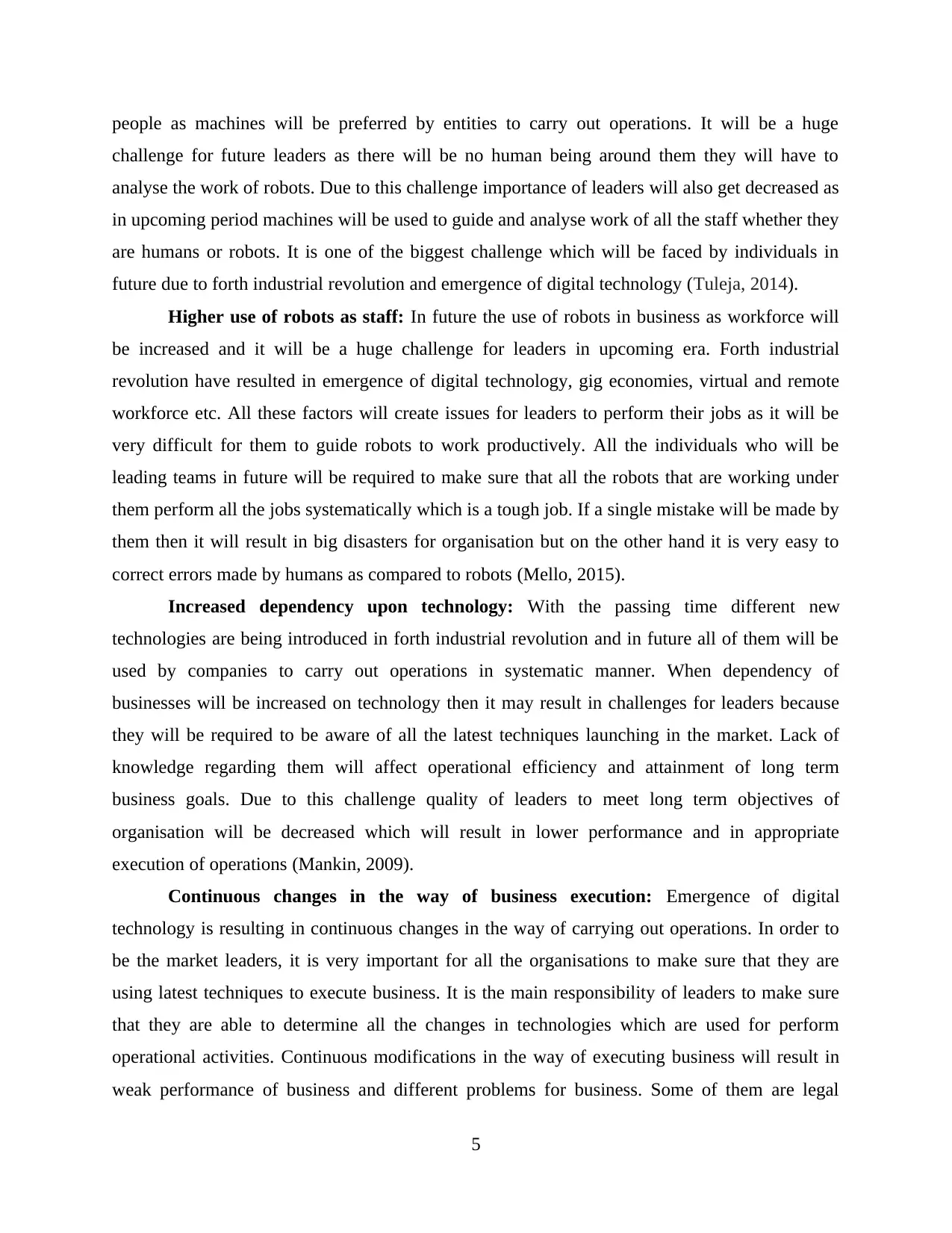
people as machines will be preferred by entities to carry out operations. It will be a huge
challenge for future leaders as there will be no human being around them they will have to
analyse the work of robots. Due to this challenge importance of leaders will also get decreased as
in upcoming period machines will be used to guide and analyse work of all the staff whether they
are humans or robots. It is one of the biggest challenge which will be faced by individuals in
future due to forth industrial revolution and emergence of digital technology (Tuleja, 2014).
Higher use of robots as staff: In future the use of robots in business as workforce will
be increased and it will be a huge challenge for leaders in upcoming era. Forth industrial
revolution have resulted in emergence of digital technology, gig economies, virtual and remote
workforce etc. All these factors will create issues for leaders to perform their jobs as it will be
very difficult for them to guide robots to work productively. All the individuals who will be
leading teams in future will be required to make sure that all the robots that are working under
them perform all the jobs systematically which is a tough job. If a single mistake will be made by
them then it will result in big disasters for organisation but on the other hand it is very easy to
correct errors made by humans as compared to robots (Mello, 2015).
Increased dependency upon technology: With the passing time different new
technologies are being introduced in forth industrial revolution and in future all of them will be
used by companies to carry out operations in systematic manner. When dependency of
businesses will be increased on technology then it may result in challenges for leaders because
they will be required to be aware of all the latest techniques launching in the market. Lack of
knowledge regarding them will affect operational efficiency and attainment of long term
business goals. Due to this challenge quality of leaders to meet long term objectives of
organisation will be decreased which will result in lower performance and in appropriate
execution of operations (Mankin, 2009).
Continuous changes in the way of business execution: Emergence of digital
technology is resulting in continuous changes in the way of carrying out operations. In order to
be the market leaders, it is very important for all the organisations to make sure that they are
using latest techniques to execute business. It is the main responsibility of leaders to make sure
that they are able to determine all the changes in technologies which are used for perform
operational activities. Continuous modifications in the way of executing business will result in
weak performance of business and different problems for business. Some of them are legal
5
challenge for future leaders as there will be no human being around them they will have to
analyse the work of robots. Due to this challenge importance of leaders will also get decreased as
in upcoming period machines will be used to guide and analyse work of all the staff whether they
are humans or robots. It is one of the biggest challenge which will be faced by individuals in
future due to forth industrial revolution and emergence of digital technology (Tuleja, 2014).
Higher use of robots as staff: In future the use of robots in business as workforce will
be increased and it will be a huge challenge for leaders in upcoming era. Forth industrial
revolution have resulted in emergence of digital technology, gig economies, virtual and remote
workforce etc. All these factors will create issues for leaders to perform their jobs as it will be
very difficult for them to guide robots to work productively. All the individuals who will be
leading teams in future will be required to make sure that all the robots that are working under
them perform all the jobs systematically which is a tough job. If a single mistake will be made by
them then it will result in big disasters for organisation but on the other hand it is very easy to
correct errors made by humans as compared to robots (Mello, 2015).
Increased dependency upon technology: With the passing time different new
technologies are being introduced in forth industrial revolution and in future all of them will be
used by companies to carry out operations in systematic manner. When dependency of
businesses will be increased on technology then it may result in challenges for leaders because
they will be required to be aware of all the latest techniques launching in the market. Lack of
knowledge regarding them will affect operational efficiency and attainment of long term
business goals. Due to this challenge quality of leaders to meet long term objectives of
organisation will be decreased which will result in lower performance and in appropriate
execution of operations (Mankin, 2009).
Continuous changes in the way of business execution: Emergence of digital
technology is resulting in continuous changes in the way of carrying out operations. In order to
be the market leaders, it is very important for all the organisations to make sure that they are
using latest techniques to execute business. It is the main responsibility of leaders to make sure
that they are able to determine all the changes in technologies which are used for perform
operational activities. Continuous modifications in the way of executing business will result in
weak performance of business and different problems for business. Some of them are legal
5
Paraphrase This Document
Need a fresh take? Get an instant paraphrase of this document with our AI Paraphraser
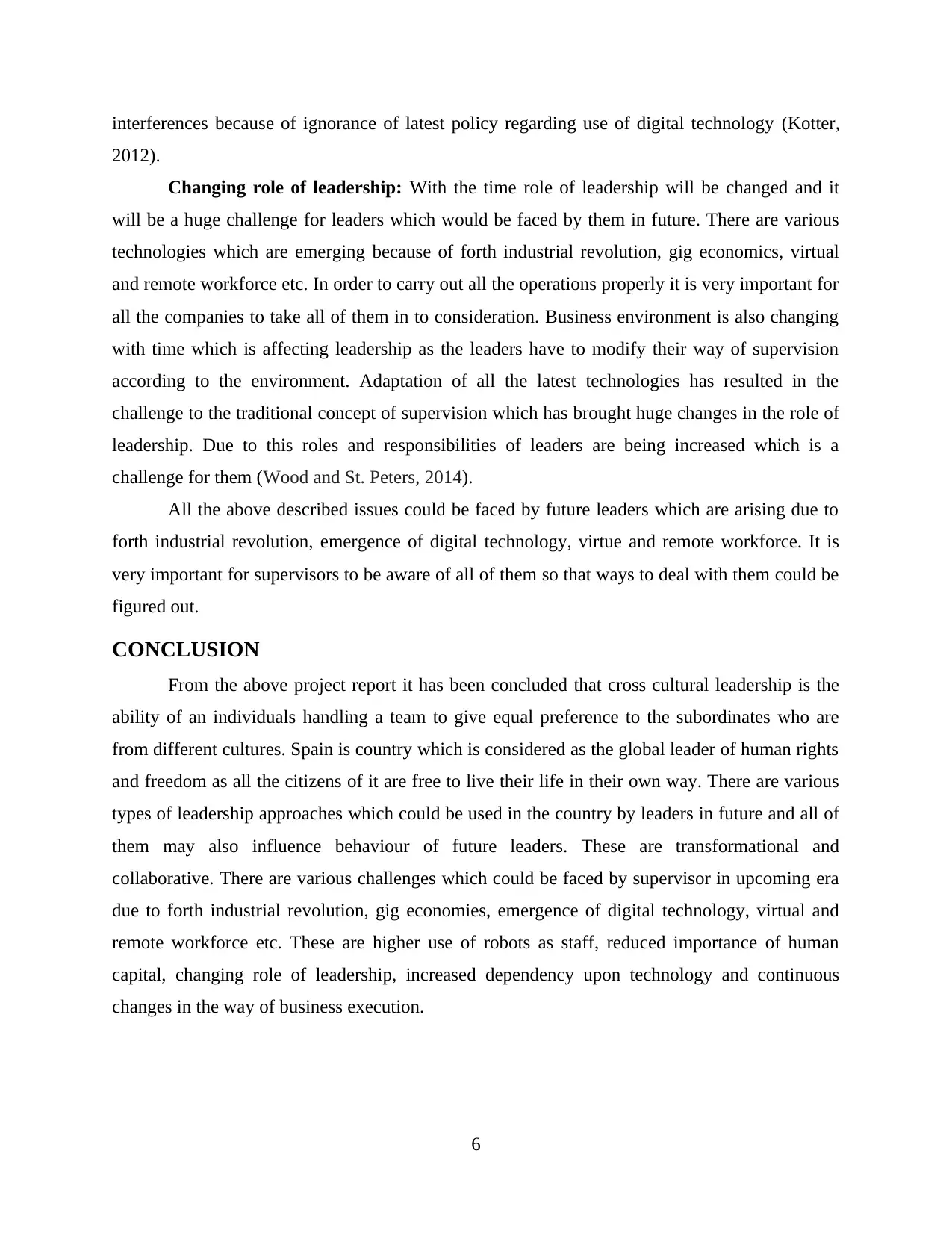
interferences because of ignorance of latest policy regarding use of digital technology (Kotter,
2012).
Changing role of leadership: With the time role of leadership will be changed and it
will be a huge challenge for leaders which would be faced by them in future. There are various
technologies which are emerging because of forth industrial revolution, gig economics, virtual
and remote workforce etc. In order to carry out all the operations properly it is very important for
all the companies to take all of them in to consideration. Business environment is also changing
with time which is affecting leadership as the leaders have to modify their way of supervision
according to the environment. Adaptation of all the latest technologies has resulted in the
challenge to the traditional concept of supervision which has brought huge changes in the role of
leadership. Due to this roles and responsibilities of leaders are being increased which is a
challenge for them (Wood and St. Peters, 2014).
All the above described issues could be faced by future leaders which are arising due to
forth industrial revolution, emergence of digital technology, virtue and remote workforce. It is
very important for supervisors to be aware of all of them so that ways to deal with them could be
figured out.
CONCLUSION
From the above project report it has been concluded that cross cultural leadership is the
ability of an individuals handling a team to give equal preference to the subordinates who are
from different cultures. Spain is country which is considered as the global leader of human rights
and freedom as all the citizens of it are free to live their life in their own way. There are various
types of leadership approaches which could be used in the country by leaders in future and all of
them may also influence behaviour of future leaders. These are transformational and
collaborative. There are various challenges which could be faced by supervisor in upcoming era
due to forth industrial revolution, gig economies, emergence of digital technology, virtual and
remote workforce etc. These are higher use of robots as staff, reduced importance of human
capital, changing role of leadership, increased dependency upon technology and continuous
changes in the way of business execution.
6
2012).
Changing role of leadership: With the time role of leadership will be changed and it
will be a huge challenge for leaders which would be faced by them in future. There are various
technologies which are emerging because of forth industrial revolution, gig economics, virtual
and remote workforce etc. In order to carry out all the operations properly it is very important for
all the companies to take all of them in to consideration. Business environment is also changing
with time which is affecting leadership as the leaders have to modify their way of supervision
according to the environment. Adaptation of all the latest technologies has resulted in the
challenge to the traditional concept of supervision which has brought huge changes in the role of
leadership. Due to this roles and responsibilities of leaders are being increased which is a
challenge for them (Wood and St. Peters, 2014).
All the above described issues could be faced by future leaders which are arising due to
forth industrial revolution, emergence of digital technology, virtue and remote workforce. It is
very important for supervisors to be aware of all of them so that ways to deal with them could be
figured out.
CONCLUSION
From the above project report it has been concluded that cross cultural leadership is the
ability of an individuals handling a team to give equal preference to the subordinates who are
from different cultures. Spain is country which is considered as the global leader of human rights
and freedom as all the citizens of it are free to live their life in their own way. There are various
types of leadership approaches which could be used in the country by leaders in future and all of
them may also influence behaviour of future leaders. These are transformational and
collaborative. There are various challenges which could be faced by supervisor in upcoming era
due to forth industrial revolution, gig economies, emergence of digital technology, virtual and
remote workforce etc. These are higher use of robots as staff, reduced importance of human
capital, changing role of leadership, increased dependency upon technology and continuous
changes in the way of business execution.
6
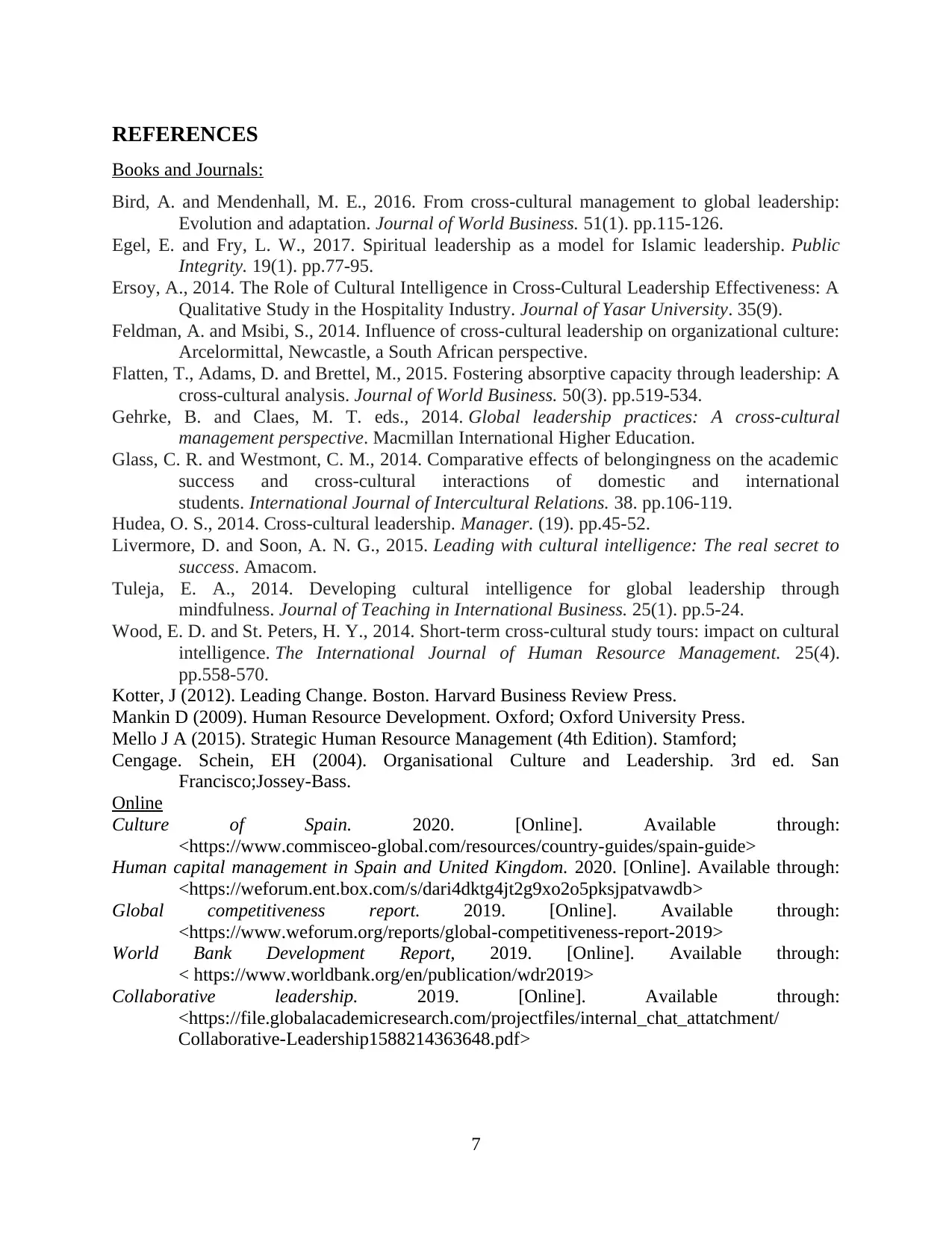
REFERENCES
Books and Journals:
Bird, A. and Mendenhall, M. E., 2016. From cross-cultural management to global leadership:
Evolution and adaptation. Journal of World Business. 51(1). pp.115-126.
Egel, E. and Fry, L. W., 2017. Spiritual leadership as a model for Islamic leadership. Public
Integrity. 19(1). pp.77-95.
Ersoy, A., 2014. The Role of Cultural Intelligence in Cross-Cultural Leadership Effectiveness: A
Qualitative Study in the Hospitality Industry. Journal of Yasar University. 35(9).
Feldman, A. and Msibi, S., 2014. Influence of cross-cultural leadership on organizational culture:
Arcelormittal, Newcastle, a South African perspective.
Flatten, T., Adams, D. and Brettel, M., 2015. Fostering absorptive capacity through leadership: A
cross-cultural analysis. Journal of World Business. 50(3). pp.519-534.
Gehrke, B. and Claes, M. T. eds., 2014. Global leadership practices: A cross-cultural
management perspective. Macmillan International Higher Education.
Glass, C. R. and Westmont, C. M., 2014. Comparative effects of belongingness on the academic
success and cross-cultural interactions of domestic and international
students. International Journal of Intercultural Relations. 38. pp.106-119.
Hudea, O. S., 2014. Cross-cultural leadership. Manager. (19). pp.45-52.
Livermore, D. and Soon, A. N. G., 2015. Leading with cultural intelligence: The real secret to
success. Amacom.
Tuleja, E. A., 2014. Developing cultural intelligence for global leadership through
mindfulness. Journal of Teaching in International Business. 25(1). pp.5-24.
Wood, E. D. and St. Peters, H. Y., 2014. Short-term cross-cultural study tours: impact on cultural
intelligence. The International Journal of Human Resource Management. 25(4).
pp.558-570.
Kotter, J (2012). Leading Change. Boston. Harvard Business Review Press.
Mankin D (2009). Human Resource Development. Oxford; Oxford University Press.
Mello J A (2015). Strategic Human Resource Management (4th Edition). Stamford;
Cengage. Schein, EH (2004). Organisational Culture and Leadership. 3rd ed. San
Francisco;Jossey-Bass.
Online
Culture of Spain. 2020. [Online]. Available through:
<https://www.commisceo-global.com/resources/country-guides/spain-guide>
Human capital management in Spain and United Kingdom. 2020. [Online]. Available through:
<https://weforum.ent.box.com/s/dari4dktg4jt2g9xo2o5pksjpatvawdb>
Global competitiveness report. 2019. [Online]. Available through:
<https://www.weforum.org/reports/global-competitiveness-report-2019>
World Bank Development Report, 2019. [Online]. Available through:
< https://www.worldbank.org/en/publication/wdr2019>
Collaborative leadership. 2019. [Online]. Available through:
<https://file.globalacademicresearch.com/projectfiles/internal_chat_attatchment/
Collaborative-Leadership1588214363648.pdf>
7
Books and Journals:
Bird, A. and Mendenhall, M. E., 2016. From cross-cultural management to global leadership:
Evolution and adaptation. Journal of World Business. 51(1). pp.115-126.
Egel, E. and Fry, L. W., 2017. Spiritual leadership as a model for Islamic leadership. Public
Integrity. 19(1). pp.77-95.
Ersoy, A., 2014. The Role of Cultural Intelligence in Cross-Cultural Leadership Effectiveness: A
Qualitative Study in the Hospitality Industry. Journal of Yasar University. 35(9).
Feldman, A. and Msibi, S., 2014. Influence of cross-cultural leadership on organizational culture:
Arcelormittal, Newcastle, a South African perspective.
Flatten, T., Adams, D. and Brettel, M., 2015. Fostering absorptive capacity through leadership: A
cross-cultural analysis. Journal of World Business. 50(3). pp.519-534.
Gehrke, B. and Claes, M. T. eds., 2014. Global leadership practices: A cross-cultural
management perspective. Macmillan International Higher Education.
Glass, C. R. and Westmont, C. M., 2014. Comparative effects of belongingness on the academic
success and cross-cultural interactions of domestic and international
students. International Journal of Intercultural Relations. 38. pp.106-119.
Hudea, O. S., 2014. Cross-cultural leadership. Manager. (19). pp.45-52.
Livermore, D. and Soon, A. N. G., 2015. Leading with cultural intelligence: The real secret to
success. Amacom.
Tuleja, E. A., 2014. Developing cultural intelligence for global leadership through
mindfulness. Journal of Teaching in International Business. 25(1). pp.5-24.
Wood, E. D. and St. Peters, H. Y., 2014. Short-term cross-cultural study tours: impact on cultural
intelligence. The International Journal of Human Resource Management. 25(4).
pp.558-570.
Kotter, J (2012). Leading Change. Boston. Harvard Business Review Press.
Mankin D (2009). Human Resource Development. Oxford; Oxford University Press.
Mello J A (2015). Strategic Human Resource Management (4th Edition). Stamford;
Cengage. Schein, EH (2004). Organisational Culture and Leadership. 3rd ed. San
Francisco;Jossey-Bass.
Online
Culture of Spain. 2020. [Online]. Available through:
<https://www.commisceo-global.com/resources/country-guides/spain-guide>
Human capital management in Spain and United Kingdom. 2020. [Online]. Available through:
<https://weforum.ent.box.com/s/dari4dktg4jt2g9xo2o5pksjpatvawdb>
Global competitiveness report. 2019. [Online]. Available through:
<https://www.weforum.org/reports/global-competitiveness-report-2019>
World Bank Development Report, 2019. [Online]. Available through:
< https://www.worldbank.org/en/publication/wdr2019>
Collaborative leadership. 2019. [Online]. Available through:
<https://file.globalacademicresearch.com/projectfiles/internal_chat_attatchment/
Collaborative-Leadership1588214363648.pdf>
7
⊘ This is a preview!⊘
Do you want full access?
Subscribe today to unlock all pages.

Trusted by 1+ million students worldwide
1 out of 9
Related Documents
Your All-in-One AI-Powered Toolkit for Academic Success.
+13062052269
info@desklib.com
Available 24*7 on WhatsApp / Email
![[object Object]](/_next/static/media/star-bottom.7253800d.svg)
Unlock your academic potential
Copyright © 2020–2025 A2Z Services. All Rights Reserved. Developed and managed by ZUCOL.





